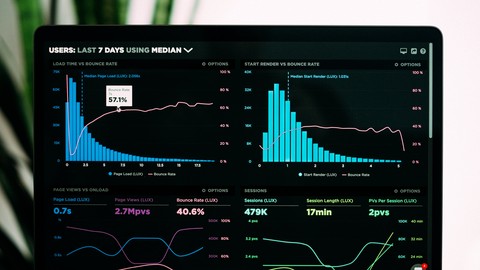
Modeling Count Data using Stata
Modeling Count Data using Stata, available at $59.99, has an average rating of 4.75, with 29 lectures, based on 57 reviews, and has 1746 subscribers.
You will learn about Understand count tables Calculate incidence-rate ratios Understand what count models are Identify when to use count models Poisson regression Negative binomial regression Truncated models Zero-inflated models Predict expected number of outcomes Apply count models using Stata Compare different models Visualise the results This course is ideal for individuals who are Beginner non-mathematical students seeking to become data scientists It is particularly useful for Beginner non-mathematical students seeking to become data scientists.
Enroll now: Modeling Count Data using Stata
Summary
Title: Modeling Count Data using Stata
Price: $59.99
Average Rating: 4.75
Number of Lectures: 29
Number of Published Lectures: 29
Number of Curriculum Items: 29
Number of Published Curriculum Objects: 29
Original Price: $24.99
Quality Status: approved
Status: Live
What You Will Learn
- Understand count tables
- Calculate incidence-rate ratios
- Understand what count models are
- Identify when to use count models
- Poisson regression
- Negative binomial regression
- Truncated models
- Zero-inflated models
- Predict expected number of outcomes
- Apply count models using Stata
- Compare different models
- Visualise the results
Who Should Attend
- Beginner non-mathematical students seeking to become data scientists
Target Audiences
- Beginner non-mathematical students seeking to become data scientists
Included in this course is an e-book and a set of slides. The course is divided into two parts. In the first part, students are introduced to the theory behind count models. The theory is explained in an intuitive way while keeping the math at a minimum. The course starts with an introduction to count tables, where students learn how to calculate the incidence-rate ratio. From there, the course moves on to Poisson regression where students learn how to include continuous, binary, and categorical variables. Students are then introduced to the concept of overdispersion and the use of negative binomial models to address this issue. Other count models such as truncated models and zero-inflated models are discussed.
In the second part of the course, students learn how to apply what they have learned using Stata. In this part, students will walk through a large project in order to fit Poisson, negative binomial, and zero-inflated models. The tools used to compare these models are also introduced.
Course Curriculum
Chapter 1: Count tables
Lecture 1: Introduction
Lecture 2: Count tables
Lecture 3: Risk
Lecture 4: Inceidence-rate ratio
Lecture 5: Two-by-three tables
Chapter 2: Poisson regression
Lecture 1: Single independent variable
Lecture 2: Examples
Lecture 3: Binary variables
Lecture 4: Multiple independent variables
Lecture 5: Categorical variables
Lecture 6: Exposure
Chapter 3: Other count models
Lecture 1: Negative binomial regression
Lecture 2: Truncated models
Lecture 3: Zero-inflated models
Lecture 4: Comparison of models
Chapter 4: Prediction
Lecture 1: Predicting the number of events
Lecture 2: Predicting probabilities of certain counts
Chapter 5: Application: Fitting the model
Lecture 1: Introduction to the dataset
Lecture 2: Continuous variables
Lecture 3: Binary variables
Lecture 4: Multivariate analysis
Lecture 5: Negative binomial regression
Lecture 6: Zero-inflated models
Chapter 6: Application: Model Comparison and Prediction
Lecture 1: Comparing count models
Lecture 2: Model interpretation: predicted number of events
Lecture 3: Model interpretation: predicted probabilities of different outcomes
Lecture 4: Visualizing the model: predicted number of events
Lecture 5: Visualizing the model: predicted probabilities of different outcomes
Chapter 7: Conclusion
Lecture 1: Conclusion
Instructors
-
Najib Mozahem
Assistant Professor
Rating Distribution
- 1 stars: 0 votes
- 2 stars: 0 votes
- 3 stars: 4 votes
- 4 stars: 15 votes
- 5 stars: 38 votes
Frequently Asked Questions
How long do I have access to the course materials?
You can view and review the lecture materials indefinitely, like an on-demand channel.
Can I take my courses with me wherever I go?
Definitely! If you have an internet connection, courses on Udemy are available on any device at any time. If you don’t have an internet connection, some instructors also let their students download course lectures. That’s up to the instructor though, so make sure you get on their good side!
You may also like
- Best Emotional Intelligence Courses to Learn in March 2025
- Best Time Management Courses to Learn in March 2025
- Best Remote Work Strategies Courses to Learn in March 2025
- Best Freelancing Courses to Learn in March 2025
- Best E-commerce Strategies Courses to Learn in March 2025
- Best Personal Branding Courses to Learn in March 2025
- Best Stock Market Trading Courses to Learn in March 2025
- Best Real Estate Investing Courses to Learn in March 2025
- Best Financial Technology Courses to Learn in March 2025
- Best Agile Methodologies Courses to Learn in March 2025
- Best Project Management Courses to Learn in March 2025
- Best Leadership Skills Courses to Learn in March 2025
- Best Public Speaking Courses to Learn in March 2025
- Best Affiliate Marketing Courses to Learn in March 2025
- Best Email Marketing Courses to Learn in March 2025
- Best Social Media Management Courses to Learn in March 2025
- Best SEO Optimization Courses to Learn in March 2025
- Best Content Creation Courses to Learn in March 2025
- Best Game Development Courses to Learn in March 2025
- Best Software Testing Courses to Learn in March 2025






















